Main achievements in 2021
approved by ISSP RAS Academic Board on December, 20, 2021
(protocol № 25)
Ginzburg-Landau theory for impure superconductors of polar symmetry
V.M. Edelshtein
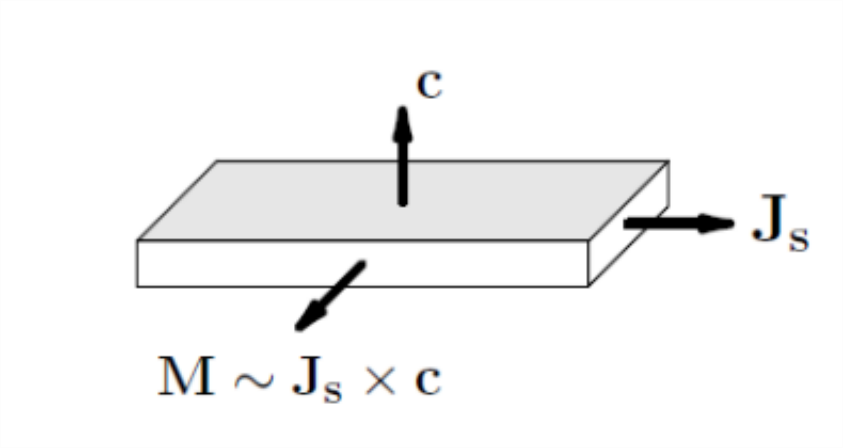
A recently published paper by Edelstein [1] deducts an expression for the free energy of a three-dimensional superconductor with broken mirror symmetry that takes into account the non-ideality of the crystal lattice.
Superconductors with such symmetry have attracted interest, since the spin-orbit coupling of conduction electrons plays a special role in them, leading to a number of unusual phenomena important for spintronics. Spin magnetization in presence of an electric current is a most well-known example (see Fig.1). This problem requires taking electron scattering into consideration due to two circumstances.
First, superconductors with broken mirror symmetry are always multi-atomic compounds, so their crystal structure often gets violated.
Second, electron scattering on impurities is the main mechanism responsible for relaxation phenomena in kinetics and optics.
The problem is solved for any relation between the impurity scattering amplitude, the spin-orbit coupling value, and the critical temperature.
Under the same conditions a formula for the magnetoelectric effect (the appearance of spin polarization density in a moving condensate) was also obtained.
As a corollary of the developed theory, the absence of spin fluxes in the state of carrying a superfluid current (the prohibition of the spin Hall effect) regardless of the presence or absence of impurity scattering is proved.
The main theoretical result is a method for calculating Feynman diagrams that differs from the standard one and fully accounts for the spin-orbit interaction.
Publication:
[1] V.M. Edelstein, Ginzburg-Landau theory for impure superconductors of polar symmetry, Phys. Rev. B 103, 094507 (2021)
Physics and technologies of new materials and structures (government contract FFUW-2019-0014)
Physical Sciences, direction 1.3.2 "Physics of Condensed Media and Physical Materials Science".
Influence of spin diffusion and spin injection on characteristics of superconductor-normal metal-superconductor Josephson transitions
V.V. Ryazanov, T.E. Golikova, G.A. Penzyakov, I.E. Batov, I.V. Bobkova, A.M. Bobkov et al.
The effect of quasi-particle and spin injections from a ferromagnet (F) into a Josephson N/F-barrier of submicron superconductor-normal metal/ferromagnet-superconductor structure (S-N/F-S structure, Fig. 2a) on the critical current, phase difference inversion, and appearance of nonlocal effects is studied.
Spin splitting of the superconducting energy gap and the mini-gap induced in the N-barrier is observed.
The spin diffusion from the F-sublayer into the N-barrier and the nonequilibrium electronic distribution caused by quasiparticle injection provided the observation of a double (0-π-0) transition with superconducting phase difference inversion (Fig. 2b), associated with a double change in direction of coherent transport in the realized sequence of states (zones) carrying the superconducting current through the Josephson barrier. The results obtained [1] are compared with the performed model calculations, which take into account the change in the superconducting current-carrying density of states and the distribution function in S-N/F-S transitions under the proximity effect of the normal barrier with the ferromagnet and superconductor, as well as spin diffusion and nonequilibrium quasiparticle injection.
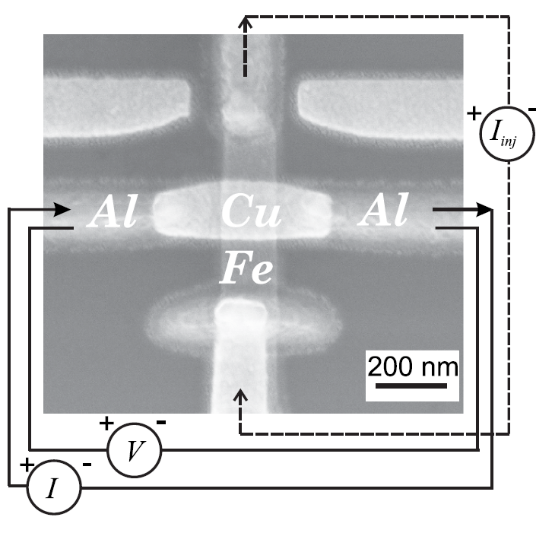 |
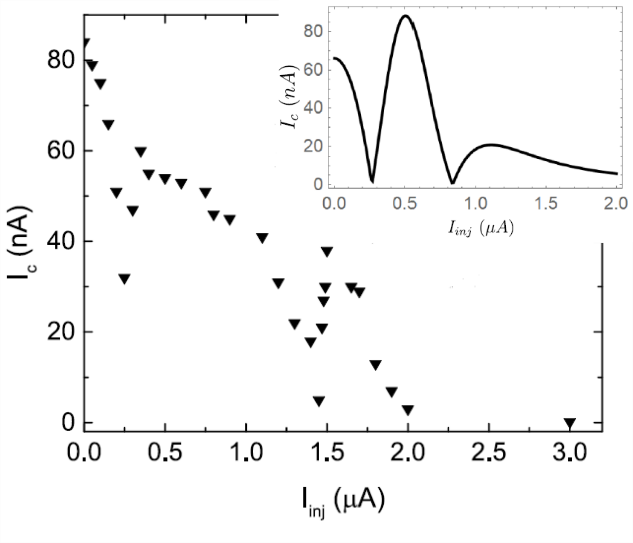 |
| a) | b) |
| Fig.2. (a) Microphotograph of a Josephson S-N/F-S structure Al-Cu/Fe-Al with a ferromagnetic (Fe) sublayer - injector of spin-polarized quasi-particles. (b) Experimental dependence of the Josephson critical current Ic in the Al-Cu/Fe-Al structure on the injection current Iinj with two (0-π-0) transitions with superconducting phase difference inversion. The inset shows the results of the theoretical model. | |
Publication:
[1] T.E. Golikova, M.J. Wolf, D. Beckmann, G.A. Penzyakov, I.E. Batov, I.V. Bobkova, A.M. Bobkov, V.V. Ryazanov, Controllable supercurrent
in mesoscopic superconductor-normal metal-ferromagnet crosslike Josephson structures, Superconductor Science and
Technology 34, 095001 (9pp), (2021) https://doi.org/10.1088/1361-6668/abfd0d
Physics and technologies of new materials and structures, (government contract FFUW-2019-0014)
Physical Sciences, direction 1.3.2. "Physics of Condensed Media and Physical Material Science".
Ordered particle structures in smectic nanofilms in microgravity
P.V. Dolganov, N.S. Shuravin, V.K. Dolganov et al.
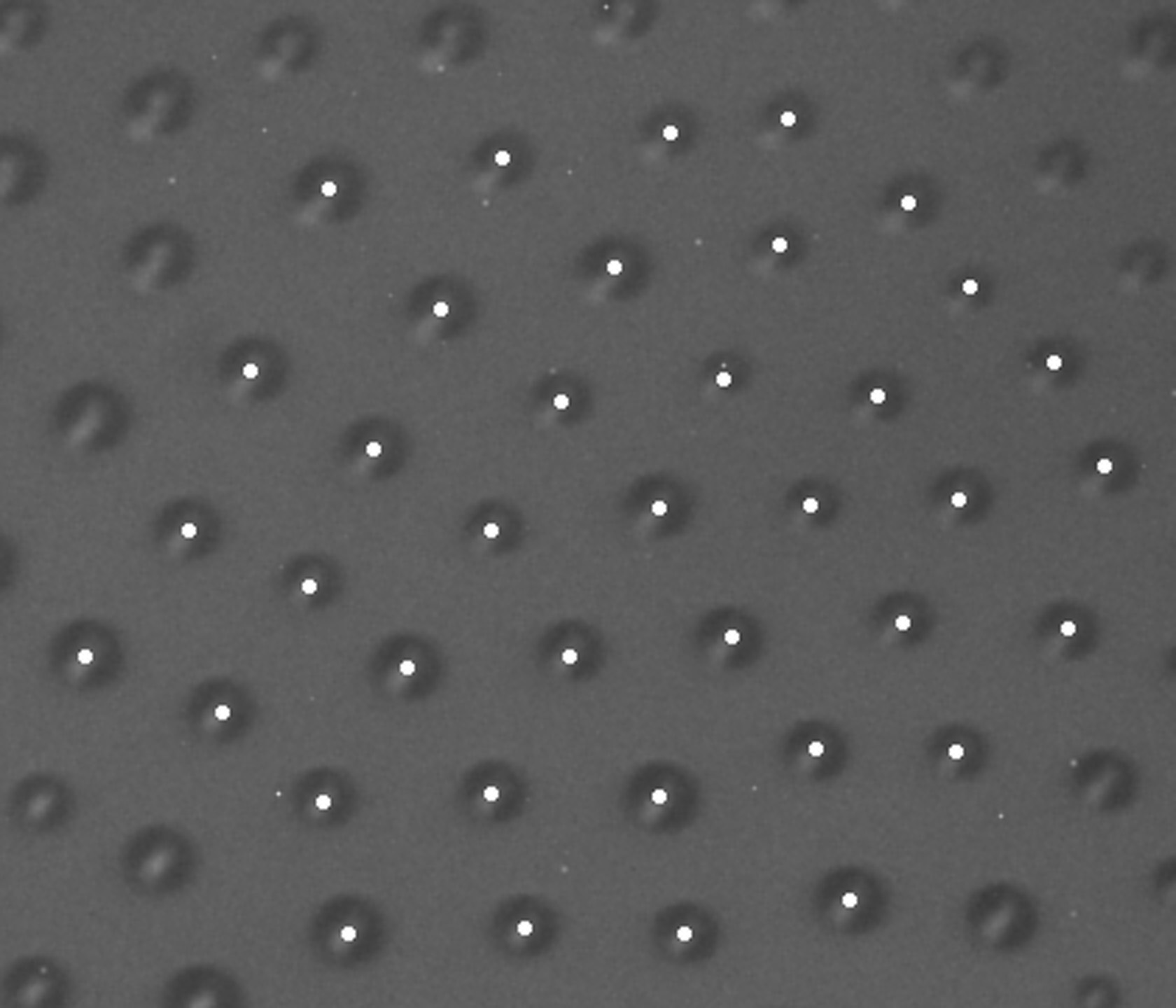
Data from a space experimental study of smectic liquid crystal nanofilms prepared in the form of a spherical bubble under microgravity conditions is analyzed. The installation was located in the U.S. sector of the International Space Station (ISS), technical support provided by American astronauts and Russian cosmonauts. The collective behavior of isotropic liquid droplets generated in smectic nanofilms at temperatures above the smectic volumetric phase transition melting is studied. The droplets were found to form a hexagonal structure with an equilibrium interparticle distance several times larger than the droplet size (see Fig. 3). The formation of a two-dimensional ordered structure may be due to layer structure deformation by the droplets. The inclusion positions are relatively wider distributed along the azimuthal direction than along the radial direction. A nontrivial dynamic behavior of the particles with periodic destruction and restoration of the hexagonal ordering is found. The present results are part of a larger data body on the structure and dynamics of smectic nanofilms obtained at ISS.
Publication:
P.V. Dolganov, N.S. Shuravin, V.K. Dolganov, E.I. Kats, R. Stannarius, K. Harth, T. Trittel, C.S. Park and J.E. Maclennan, Transient hexagonal
structures in sheared emulsions of isotropic inclusions on smectic
bubbles in microgravity conditions, Scientific Reports 11, 19144
(2021).
The work of the ISSP group is supported by the project 18-12-00108 of Russian Science Foundation (RSF) and a federal state unitary enterprise Central Research Institute for Machine Building (CRIMB).
Physical Sciences, direction 1.3.2. "Physics of Condensed Media and Physical Material Science".
Optical terahertz elements fabricated by sedimentation of colloidal suspension
V.E. Ulitko, G.M. Katyba, I.N. Dolganova, V.M. Masalov, G.A. Emelchenko, I.M. Shmytko, V.N. Kurlov et al.
A method for shaping optical surfaces of terahertz (THz) elements based on artificial opals is developed which does not require mechanical processing. Within the method, a pre-prepared form in used, making optical surfaces of complex geometry obtainable. To demonstrate this method an axicon (see Fig.4 (c)) with an apex angle =160° was made using plexiglas forms (see Fig.4 (b)); the assembled deposition form is shown in Fig.4 (a). The THz field transformation by the axicon is investigated (see Fig.4 (d)) on a THz imaging setup; the THz field theoretical distribution behind the axicon is obtained using computational electrodynamics methods (see Fig.4 (e)). The experiment and theory demonstrate good agreement, i.e. opal matrices are a promising material for THz optics. Considering high thermal stability of the material (up to 900-1100°C, depending on the material synthesis) and biocompatibility, this material can be used to solve many theoretical and applied problems of modern physics.
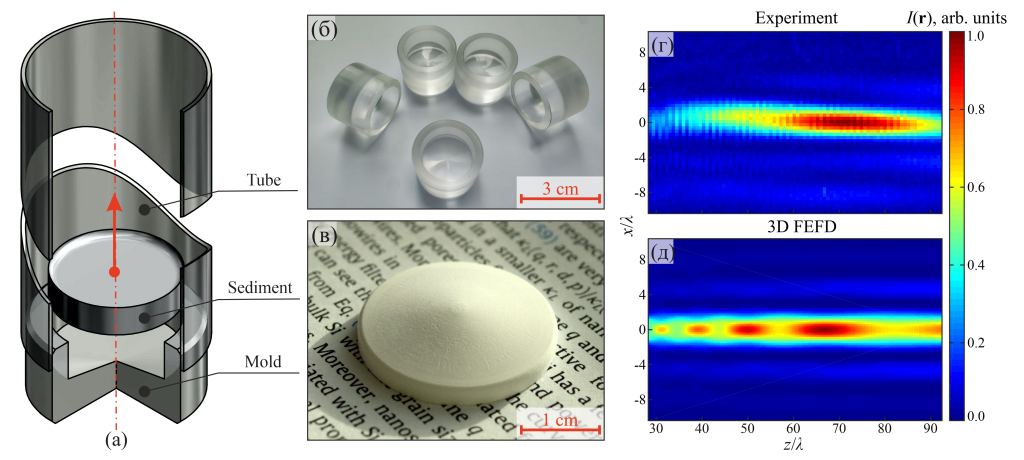
Publications:
-
Ulitko
V.E., Katyba G.M., Zhelnov V.A., Shmytko I.M., Emelchenko G.A.,
Spector I.E., V.M. Masalov, V.N. Kurlov, K.I. Zaytsev, M.
Skorobogatiy,
“Opal-based terahertz optical elements fabricated by self-assembly of porous SiO2 nanoparticles,” Optics Express 29(9), 13764-13777 (2021), DOI: 10.1364/OE.422637. - Ulitko V.E., Kurlov V.N., Masalov V.M., Dolganova I.N., Chernomyrdin N.V., Zaytsev K.I., Katyba G.M., “Terahertz axicon fabricated by direct sedimentation of SiO2 colloidal nanoparticles in a mold”, Proceedings of SPIE, 118270M (2021), DOI: 10.1117/12.2593600.
- V.E. Ulitko, V.M.Masalov, I. A. Shikunova, A.A. Gavdush, K.I. Zaytsev, V.N. Kurlov “Method of obtaining flat-convex THz optical elements from silica-based opals” Patent of invention №2756386, 2021.
The work is supported by RSF grant № 19-12-00402
Physical Sciences, direction 1.3.5. "Optics and Laser Physics"
A new molybdenum alloy developed at ISSP RAS in cooperation with Institute of Metallurgy and Material Science RAS and OAO "Kompozit"
M.I. Karpov, V.I. Vnukov, B.A. Gnesin, I.B. Gnesin, D.V. Prokhorov, T.S. Stroganova, I.S. Zheltyakova et al.
A new heat-resistant molybdenum-based alloy capable of withstanding the load of 300 MPa at 1600°C has been developed. The distinctive feature of the alloy is high purity of oxygen, which is the most harmful tramp element. The initial billet for the alloy is produced from an ingot obtained by sequential vacuum electron-beam and vacuum electric arc melting. The alloy products are made by classical pressure and heat treatment methods. Also, alloy pellets are obtainable for subsequent application in additive technologies.
Both molybdenum and its alloys are widely used as a structural material in the aerospace, electronics and nuclear power industries. At present, due to development of new generation of nuclear reactors, including space-based ones, as well as developing hypersonic aviation and space technology, new increasingly durable alloys which can resist temperatures of 1600°C and above need to be created. Molybdenum-based alloys are the most promising for such purposes. Their density is significantly lower than that of tantalum and tungsten-based alloys, which is important for aviation and space equipment. Due to the high oxygen purity of the ingots and special alloying, melting technologies while manufacturing allow to obtain the material with high ductility at room temperature. High oxygen purity also allows to use electron-beam or laser welding in production. Development batches are produced on the pilot base of ISSP RAS and delivered to OAO "Kompozit" for testing. The new alloy considerably surpasses the currently applied molybdenum alloys in heat resistance.
For example, the tensile test at 1450°С proved its ultimate strength to be more than 3 times higher than the ultimate strength of molybdenum alloy “TSM-7”.
Publications:
The new alloy is undergoing the procedure of patenting.
Physical Sciences, direction 1.3.2. "Physics of Condensed Media and Physical Material Science".
The electrocaloric effect in thin conducting ferroelectric SnSe crystal flakes
N.N. Orlova, A.V. Timonina, N.N. Kolesnikov, E.V. Devyatov
The recently aroused interest in conducting systems with broken symmetry of various types is related not only to the surface states in topological materials but also to the bulk ferroelectric and ferromagnetic properties of such systems. One of the complex physical phenomena for ferromagnetic and ferroelectric systems is the caloric effect, which is just as important for practical application. For example, using the caloric effect is supposed to be important for the development of new environmentally friendly cooling methods suitable for renewable energy source development. So far, electrocaloric effect has been demonstrated in ferroelectric dielectrics, while significant conductivity in a ferroelectric system opens up more possibilities for controlling the effect. In this work, we investigate the thermoelectric response of thin (100 nm) single-crystal SnSe flakes in constant electric field. The thermoelectric response is measured as a second-harmonic response, which reflects the magnitude and sign of the temperature gradient in the sample. The dependences obtained are strongly nonmonotonous. Besides, we demonstrate that the sign of the resulting temperature gradient is controlled by the constant electric field applied to the sample. The result demonstrates a strong electrocaloric effect in a conducting ferroelectric system (about 0.5 K at room temperature, which is comparable to maximum values achieved for ferroelectric insulators) and opens up new possibilities for its in-situ detection and control, particularly, by the electric field induced by the flowing current in the conducting system.
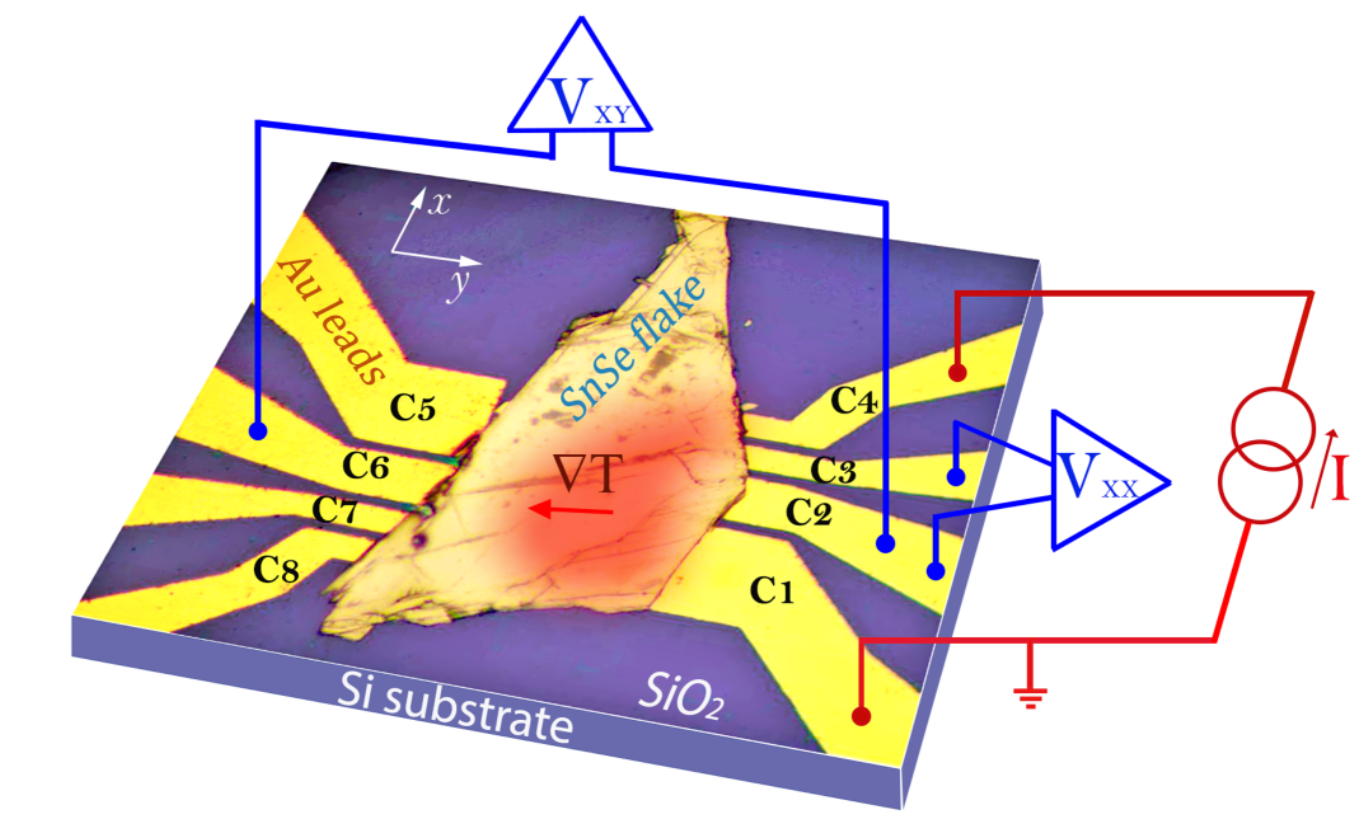
Publication:
Phys. Rev. B 104, 045304 (2021) https://doi.org/10.1103/PhysRevB.104.045304
Collective phenomena in electronic and exciton systems in semiconductor nanostructures (government contract FFUW-2019-0015)
Physical Sciences, direction 1.3.2. "Physics of Condensed Media and Physical Materials Science"
Condensation of Laughlin anyonic complexes
L.V. Kulik, A. S. Zhuravlev, L. I. Musina, E. I. Belozerov, A. B. Vankov, O. V. Volkov, A. A. Zagitova, I. V. Kukushkin et al.
Two-dimensional electron systems in a quantizing magnetic field are regarded as of exceptional interest, considering the possible role of anyons — quasiparticles with non-boson and non-fermion statistics — in applied physics (as applied to topological quantum computing). To this day, essentially none but the fractional states of the quantum Hall effect (FQHE) have been experimentally realized as a system with anyonic statistics. In determining the thermodynamic properties of anyon matter in fractional states, it is crucial to gain insight into the physics of its neutral excitations. For the first time, we form a macroscopic quasi-equilibrium ensemble of neutral excitations - spin one anyon complexes in the Laughlin state ν = 1/3, experimentally, where ν is the electron filling factor. The ensemble is found to have such a long lifetime (over 10 s) that it can be considered the new state of anyon matter. The properties of this state are investigated by optical techniques to reveal its Bose properties. Thus, for the first time quasi-particles with anyon statistics from fermions (electrons) were experimentally formed by adding magnetic flux quanta to the electron system. As a result, material system of exceptional interest for quantum calculations is obtained.
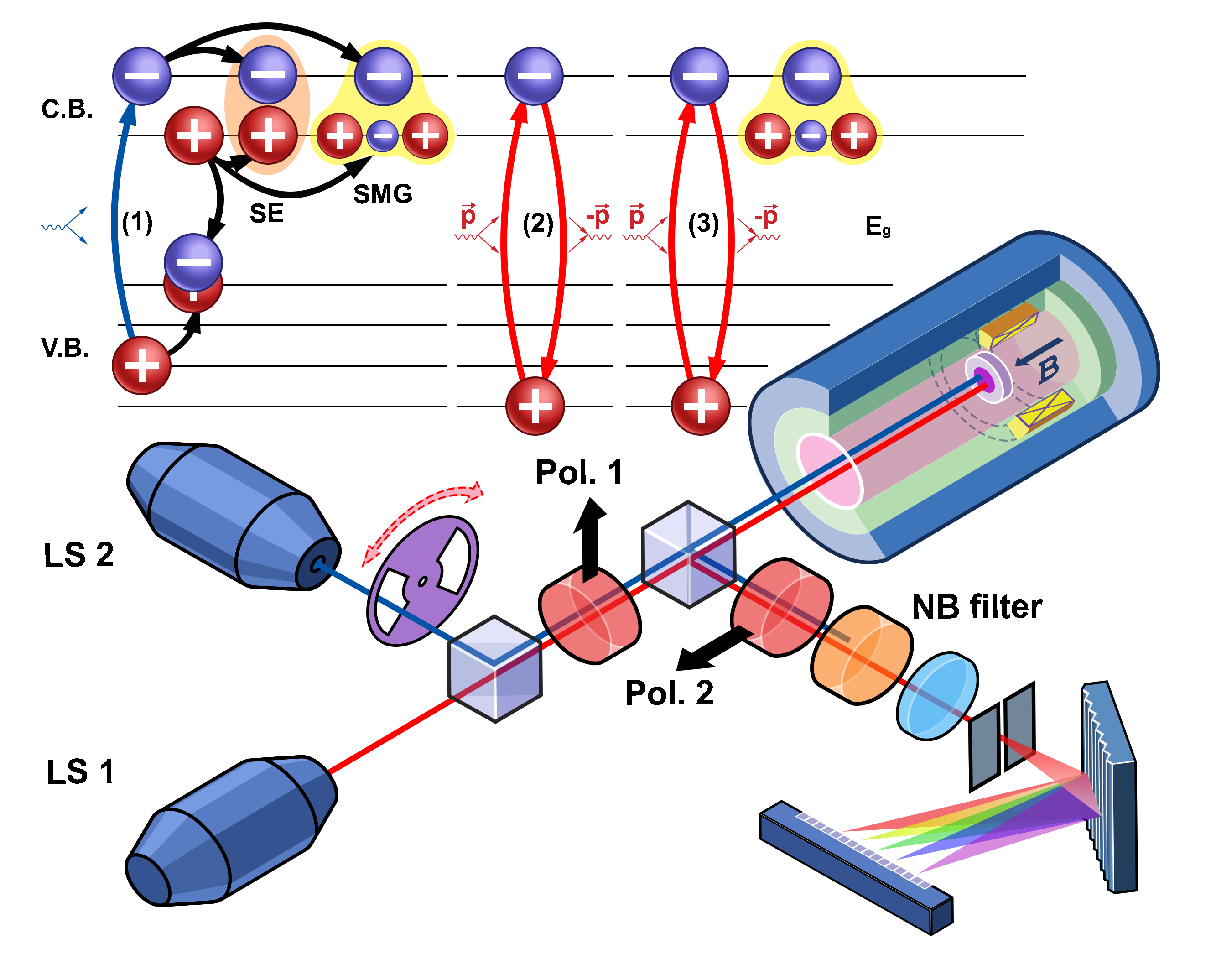
Publication:
L.V.
Kulik, A.S. Zhuravlev, L.I. Musina, E.I. Belozerov, A.B. Vankov, O.V.
Volkov, A.A. Zagitova, I.V. Kukushkin, V.Y. Umansky, Laughlin, anyon
complexes with Bose properties, Nature Communications 12, Article
number: 6477 (2021).
The work is supported by RSF grant №18-12-00246.
Physical Sciences, direction 1.3.2. "Physics of Condensed Media and Physical Materials Science"
Key implementable findings in 2021
approved by ISSP RAS Academic Board on December, 20, 2021
(protocol № 25)
Express analysis of gas with surface enhanced Raman scattering waveguide resonator
Express analysis of gas with surface enhanced Raman scattering waveguide resonator
M. N. Khannanov, A. B. Vankov, V. E. Kirpichev, L. V. Kulik, I. V. Kukushkin
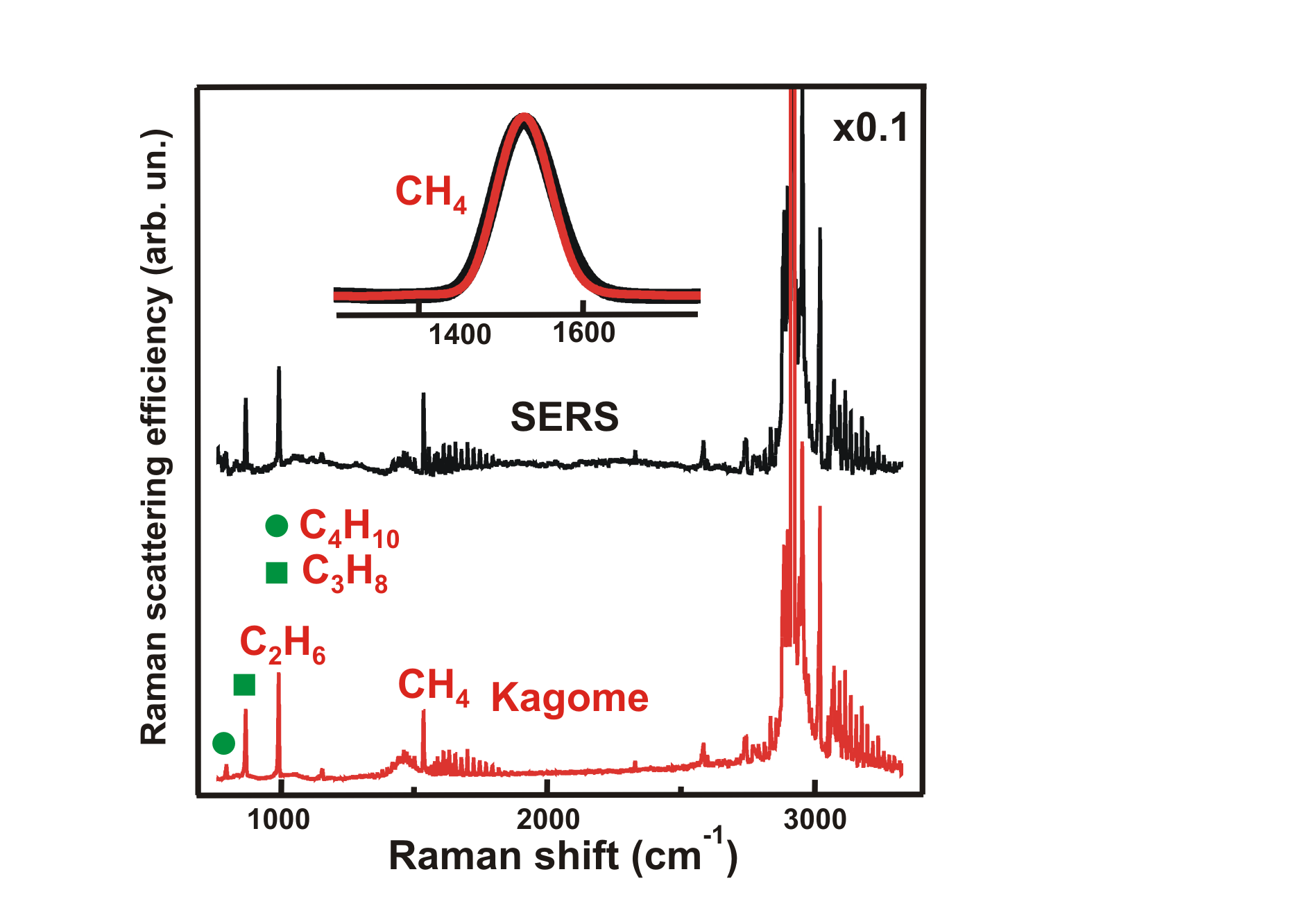
Various aspects of surface enhanced Raman scattering amplification in gases have been investigated utilizing active metal surfaces and waveguide resonators. We demonstrate that surface enhanced Raman scattering amplification in gases is not as selective as in liquids. Thus, we develop a portable express analyzer of gas based on a surface-enhanced waveguide resonator. Its Raman scattering gain coefficient is compared quantitatively with that of a bulk Kagome Raman resonator. Examples of practical implementation of the express analyzer of gas based on a surface-enhanced waveguide resonator are given. A method of express analysis of natural gas has been developed, which can be carried out within several seconds with chromatographic precision and with the limit of gas component detection from methane to isobutane with partial pressure in a mixture up to 1%. The Figure shows comparison of natural gas spectra obtained by a Kagome Raman resonator and by a portable express analyzer based on a surface-enhanced waveguide resonator (SERS).
Publication:
M. N. Khannanov, A.B. Vankov, V.E. Kirpichev, L.V. Kulik, I.V.
Kukushkin, Express Analysis of Gas With Surface Enhanced Raman
Scattering Waveguide Resonator, IEEE Sensors Journal 21, 24142 -
24148 (2021).
This work was supported by Russian Science Foundation Grant No. 19-72-30003
Physical Sciences, direction 1.3.2. "Physics of Condensed Media and Physical Materials Science"
SERS-based aptasensor for rapid quantitative detection of SARS CoV-2
D. Gribanyov, V. Kukushkin et al.
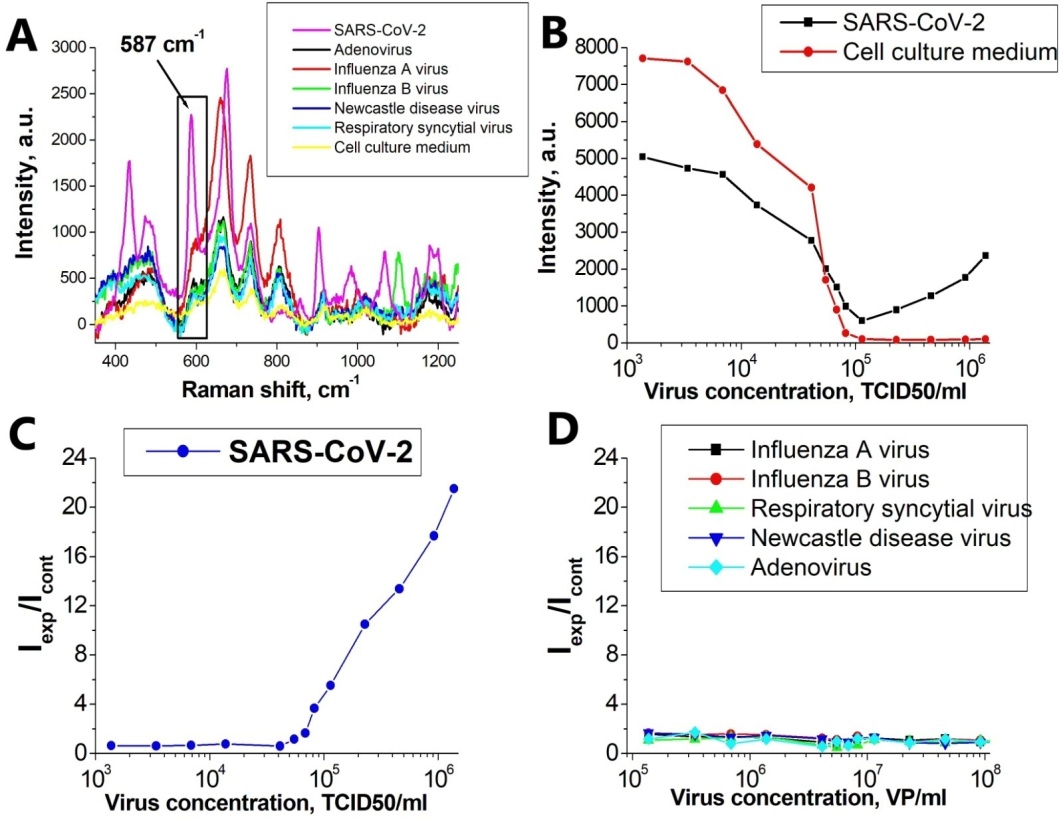
An express method for SARS-CoV-2 coronavirus detection based on direct assembly method of an optical sensor using colloidal silver nanoparticles amplifying the Raman scattering signal and aptamers recognizing the RBD (receptor-binding domain) of SARS-CoV-2 surface protein has been developed. This method is simple, single-step and fast (analysis time 7 minutes), sensitive (detection limit: 5.5 × 10^4 TCID50/ml) and specific (quantitative detection and identification of SARS-CoV-2 from other respiratory viral infections has been demonstrated). It is shown that as the concentration of protein molecular structures increasies, silver nanoparticles form "complexes" with them, resulting in electrical field inhomogeneity. Due to the interaction with the labeled aptamer, SARS-CoV-2 virus creates a locally increased Raman tag density near itself. Therefore, at high concentrations of nonspecific analyte the signal drops, whereas for specific (SARS-CoV-2)the signal increases.
Publication:
E. Zavyalova, O. Ambartsumyan, G. Zhdanov, D. Gribanyov, V. Gushchin, A.
Tkachuk, E. Rudakova, M. Nikiforova, N. Kuznetsova, L. Popova, B.
Verdiev, A. Alatyrev, E. Burtseva, A. Ignatieva, A. Iliukhina, I.
Dolzhikova, A. Arutyunyan, A. Gambaryan, V. Kukushkin. SERS-Based
Aptasensor for Rapid Quantitative Detection of SARS-CoV-2.
Nanomaterials. 2021; 11(6):1394. https://doi.org/10.3390/nano11061394
This work was supported by RFBR grant № 20-04-60077 and government contract "Collective phenomena in electronic and exciton systems in semiconductor nanostructures" (FFUW-2019-0015)
Physical Sciences, direction 1.3.2. "Physics of Condensed Media and Physical Materials Science"
Producing large-size articles from modified recrystallized silicon carbide
S.L. Shikunov, A.E. Ershov , I.A. Shikunova , V.N. Kurlov
A method of producing large-size articles from silicon carbide ceramics for structural purposes has been developed. It is based on the technology for producing recrystallized silicon carbide (RSiC), which is used for producing silicon carbide electric heaters (SCEH), i.e. large-sized tubular products. RSiC is highly thermally and electrically conductive, chemically and thermally resistant, and has a low thermal expansion coefficient. However, due to high open porosity and weak grain cohesion (Fig. 3a), the material has low strength characteristics. The method of volumetric compaction of porous silicon carbide framework has been developed by introducing carbon components into it with subsequent siliconization. The formation of additional bonds between particles of SiC framework (see Fig. 3b) not only leads to a significant (~10 times) increase in mechanical strength of the resulting material, but also in a controlled manner changes the electrical characteristics of heating elements, as well as significantly increase the cracking resistance of ceramics at high operating temperatures and thermal cycling.
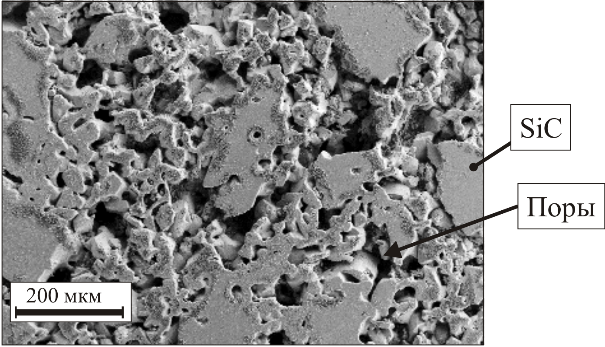 |
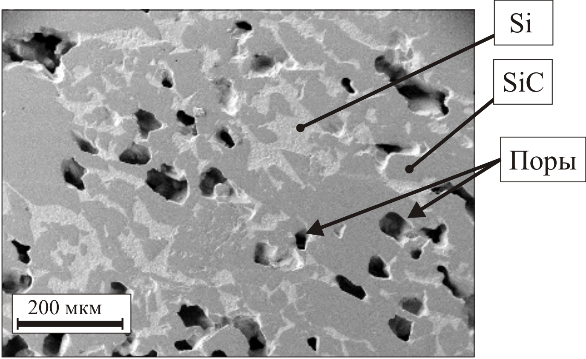 |
| (a) | (b) |
| Fig. 3. Recrystallized silicon carbide microstructure (a) before and (b) after modification /td> | |
 (a)
(a) (б)
(б)
Publications:
S.L.
Shikunov, I.A. Shikunova, V.N. Kurlov, " A Method of making
products from silicon carbide ceramics", patent for invention №
2740984, 2021.
Government contract "Physics and technology of new materials and structures", (FFUW-2019-0014).
Physical Sciences, direction 1.3.2. "Physics of Condensed Media and Physical Materials Science".




